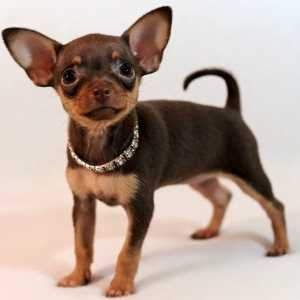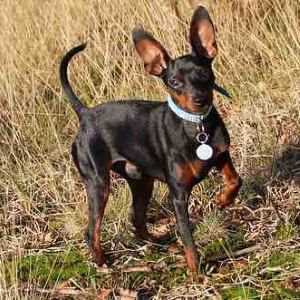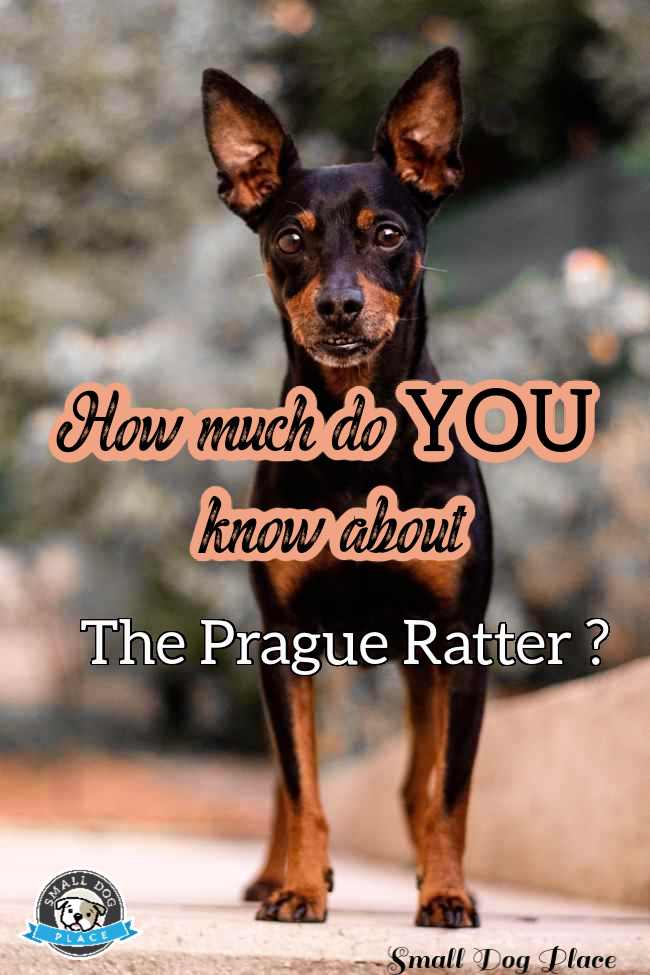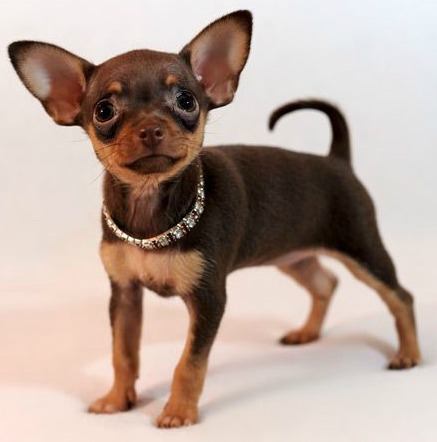The Prague Ratter (aka) Pražský Krysařík
All About Prague Ratter: The Smallest Dog By Janice Jones |Published January 15, 2020
Never heard of the Pražský Krysařík or Prague Ratter? You're not alone. This is a rare dog breed originating from the Czech Republic. Though they look surprisingly similar to other dog breeds you may have encountered, they are a breed apart and also extremely tiny.
Pražský means Prague and Krysařík means ratter.
They were renowned for killing rats, and that is how they got their name. Their tiny size, alert temperament, keen sense of smell, and speed made them the perfect candidate for reducing the rat population in the Europe of the Middle Ages. Today, however they are considered a companion breed, as their ratting days are over.
 The Prague Ratter (aka) Pražský Krysařík
The Prague Ratter (aka) Pražský KrysaříkCommonly known as the national dog of the Czech Republic, the Prague Ratter is also believed to be the smallest dog breed in the world. Some consider them to be a national treasure.
The dog is typical of 7 to 9 inches in height (20-23 cm) and 3-7 pounds in weight, (1.5 to 3.5 kg) with a lean body wrapped in thin skin.
Quick Facts
Other Names Used: Pražský Krysařík
Affiliation: FCI, ARBA (American Rare Breed Association) Group 9
Coat Type: Glossy, Short, Smooth
Colors: black and tan, brown and tan, blue and tan, lilac and tan, fawn, red, pink, blue merle, brown merle
Activity Level: Moderate
Life Expectancy: 12-14 years
Good with Children: Not recommended for very small children
Good with other pets: Yes
Litter Size: 2-3 Puppies
Average Cost: $1000-2500
A Brief History of the Prague Ratter
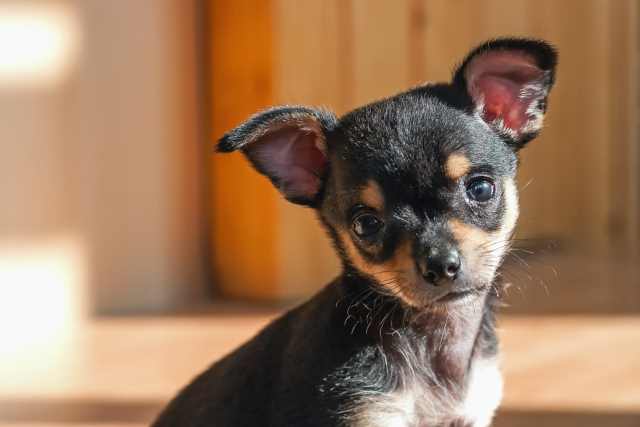 Black and Tan Prague Ratter
Black and Tan Prague RatterIt is very difficult to trace these dogs to their beginnings, but according to Gala Anonym wrote that the Polish King Boleslav II the Generous (1058-1080) was enamored by the breed and received two from Bohemia (Czech lands).
In the very early history of Bohemia, this breed was often given as a gift to other European rulers. Once the domain of royal palaces, they eventually found their way into society.
The dog was considered to be a status symbol among the kings, princes, and other officials back in the date. But he was best known for his ratting abilities, a sought after skill of the time.
As you may recall, the Middle Ages was a time of devastating plagues brought on and carried by the rat flea. The bubonic plague epidemic (Black Death) killed some 30% to 60% of the European population at the time.
The popularity of the Prague Ratter declined in the 19th century when the Miniature Pinscher (a German breed that looks remarkably similar to the Prague Ratter) became popular.
The popularity of this dog declined during the world wars. As was the case with many dog breeds, both World War I and then World War Two took a tremendous toll on the dog populations of Europe as dog breeding became secondary to war efforts.
However, the dog managed to survive over the years. They went through a renaissance in the 1980s as Czechs and Slovaks started to breed them again.
Today they are found world-wide in very limited numbers. Many of the foundation stock of this breed are exported from the Czeck Republic.
They are recognized by the FCI Fédération Cynologique Internationale and the American Rare Breed Association.
Similar But Different Breeds
Appearance
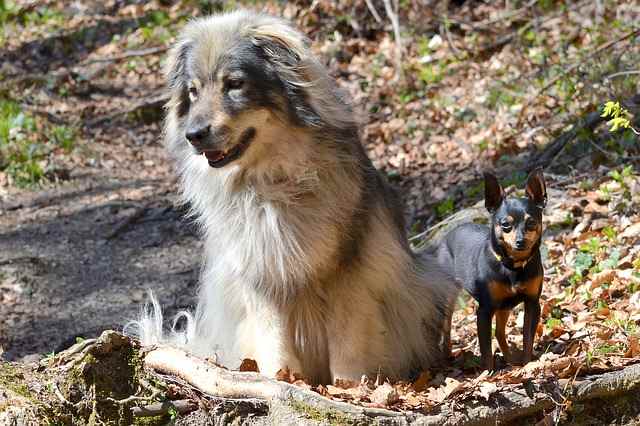 This Prague Ratter is standing side-by-side a Karst Shepherd to give you an idea of their size.
This Prague Ratter is standing side-by-side a Karst Shepherd to give you an idea of their size.Prague Ratter holds a strong resemblance to Miniature Pinscher, but these are slightly smaller in size than them. They carry a lean and elegant look with skinny legs and a graceful, long neck. They are short and firm with an upright tail, which is always set high.
Out of all the dog breeds, the Prague Ratter is the smallest, and it has very short, glossy, and black hair. Some dogs even have brown hair around their nose, legs, and torso. Their head is pear-shaped with projecting cheeks, and somewhat bulging dark brown eyes.
They have a compact body with a muscular, firm, and straight look. Their ears are erect as if they are always alert and attentive. They have a life expectancy of around 13 years.
The dog is perfect for living in small areas or for apartment life because of their size.
The personality of the Prague Ratter
| Traits | Rating |
|---|---|
| Playfulness | |
| Affection Level | |
| Friendliness Towards Strangers | |
| Good with Children | |
| Good with Other Dogs | |
| Good for First Time Owners | |
| Exercise Needed | |
| Ease of Training | |
| Watch Dog Ability | |
| Grooming Requirements | |
| Shedding | |
| Cold Tolerant | |
| Heat Tolerant |
Explanations for At a Glance Ratings
- Playfulness: Most=5 Less=1
- Affection: Most=5 Least=1
- Friendliness Towards Strangers: Most=5 Least=1
- Good with Children: Good=5 Not Good=1
- Good with Other Dogs: Good=5 Not Good=1
- Good for First Time Owners: Good=5 Not Good=1
- Amount of Exercise Required: Much=5 Minimal=1
- Ease of Training: Easy=5 Difficult=1
- Watch Dog Ability: Excellent=5 Poor=1
- Grooming Needs: Extensive=5 Minimal=1
- Shedding: Heavy Shedding=5 Minimal Shedding=1
- Cold Tolerance: Cold Well Tolerated=5 Poorly Tolerated=1
- Heat Tolerance: Heat Well Tolerated=5 Poorly Tolerated=1
The Breed standard describes the ideal temperament of the breed.
"It is gentle, cuddly and very curious. When running, it is very fast, agile and tireless. He is friendly and affectionate to his owner and family members. He is distrustful and distant of strangers. It fits into any family that appreciates its natural elegance and sweet nature."
The Prague Ratter is very active and lively. They are brave, have a lot of energy, and are always ready to play. In addition to this, they are very social and like to be around people. Also, they bond well with their human parents.
Ratters can learn to do tricks, follow orders, and play games very quickly. It is essential to socialize, train them, keep them active, and exercise them daily.
They are very obedient and love their family, As they grow, they become more relaxed and calm, but still stay loving and social. Separation anxiety can become a problem in this breed.
Due to their strong prey drive, they may not be the best choice for families who have other small pocket pets. Hamsters and the like are likely to be seen as prey and won't be safe.
A regular exercise program is a must for these active dogs and a daily walk is recommended. Romps in the back yard are also important to keep them stimulated both physically and mentally.
Grooming and Care
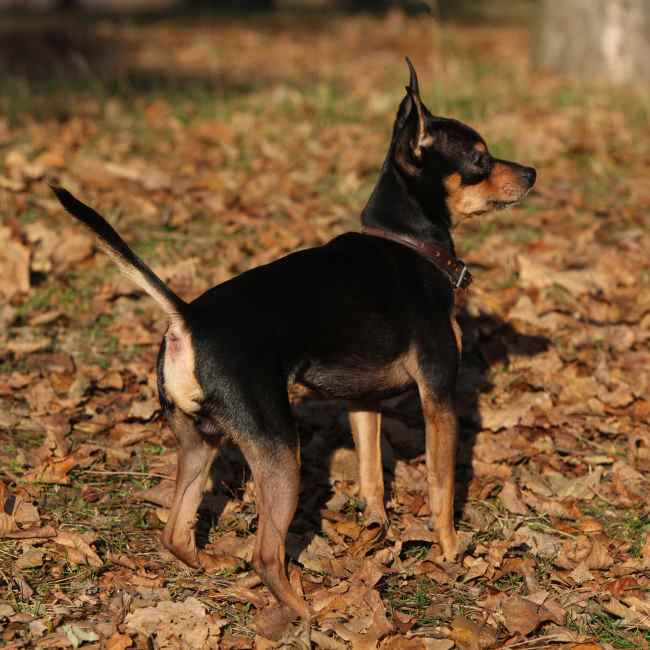 Here's a breed for all seasons!
Here's a breed for all seasons!Though a prevalent practice among owners of tiny dogs, the Prague Ratter should not be carried in a handbag. They need regular exercise. Their intelligence is the reason behind them being an excellent learner who appreciates all kinds of activities, including coursing, agility, and dancing.
The Prague Ratter does not tolerate the cold well due to its short fur, so it must be dressed appropriately during the harsh winter season. A warm sweater or winter coat will help keep your dog warm during winter walks.
Although regular grooming is not required, the smooth fur of the dog stays shiny and healthy when brushed every other day.
Since they are tiny in size, great care must be taken while playing with them. If there are children at home, care must be taken that they do not step on the dog or play rough with him.
The dog is prone to the problem of broken bones or dislocated kneecaps due to their fragile body structure. Always supervise children when playing with these small dogs.
Grooming routines for this breed including bathing regularly, brushing with a bristle brush on rubber curry brush, clipping their nails, and routinely brushing their teeth.
Health
The Prague Ratter is a healthy breed with a life span estimated at 12 to 14 years. Since it is a rare breed, genetic issues have not always been recorded. Like all dogs, they can
get infectious diseases and parasites, so keeping up with vaccines and yearly
vet appointments are encouraged.
Bone Fractures
Since they are so tiny but active and curious, they are prone to fractures. While it’s nearly impossible to protect them from everything, be sure that your home and outside areas are puppy-proofed and have no hidden dangers that could cause harm.
Patellar Luxation
Patellar Luxation is another problem that many small, slender dogs have. It occurs when the knee cap pops in and out of its socket. Pain and lameness follow. Read more about Patellar luxation.
Retained Baby Teeth
Another common issue that many tiny breeds encounter is retained baby teeth. If deciduous teeth remain after the adult teeth have erupted, a veterinarian will need to pull any remaining baby teeth. This can be done when you have your dog spayed or neutered.
Pin for Future Reference
Pros and Cons of This Breed
Pros of the Prague Ratter
- Sweet, loving, loyal
- Smart
- Tiny size makes them less expensive to feed, easy to transport
- Relatively easy to train
- Relatively healthy breed with few genetic issues
Cons
- Very rare; expect to wait for a new puppy
- Not likely to find these dogs easily in a shelter or rescue
- High Prey Drive means they may chase, dig
- Not well suited to families with very young children
- Not a good choice for couch potatoes; need daily exercise
About Janice (author and voice behind this site)
Having lived with dogs and cats most of her life, Janice served as a veterinary technician for ten years in Maryland and twelve years as a Shih Tzu dog breeder in Ohio.
Her education includes undergraduate degrees in Psychology with a minor in biology, Early Childhood Education, and Nursing, and a master's in Mental Health Counseling.
She is a lifelong learner, a dog lover, and passionate about the welfare of animals. Her favorite breed for over 50 years has been the Shih Tzu, but she has also lived with Poodles, Maltese, Yorkshire Terriers, Beagles, English Bulldogs, Carin Terriers, and a Cocker Spaniel.
When not writing, reading, and researching dog-related topics, she likes to spend time with her eight Shih Tzu dogs, husband, and family, as well as knitting and crocheting. She is also the voice behind Miracle Shih Tzu and Smart-Knit-Crocheting
Does This Article Deserve Your Thumbs Up?
We always appreciate your support and encouragement. Your thumbs up means so much to us. Please like this article.
If you find this page or any page on Small Dog Place Helpful, or useful in anyway, I'd love it if you would click the small heart found on the bottom right of each page.
You can also share or bookmark this page -- just click on the:

Free Monthly Newsletter
Sign Up for Our Free Newsletter and get our Free Gift to You.
my E-book, The Top 10 Mistakes People Make When Choosing a Dog (and how to avoid them)
